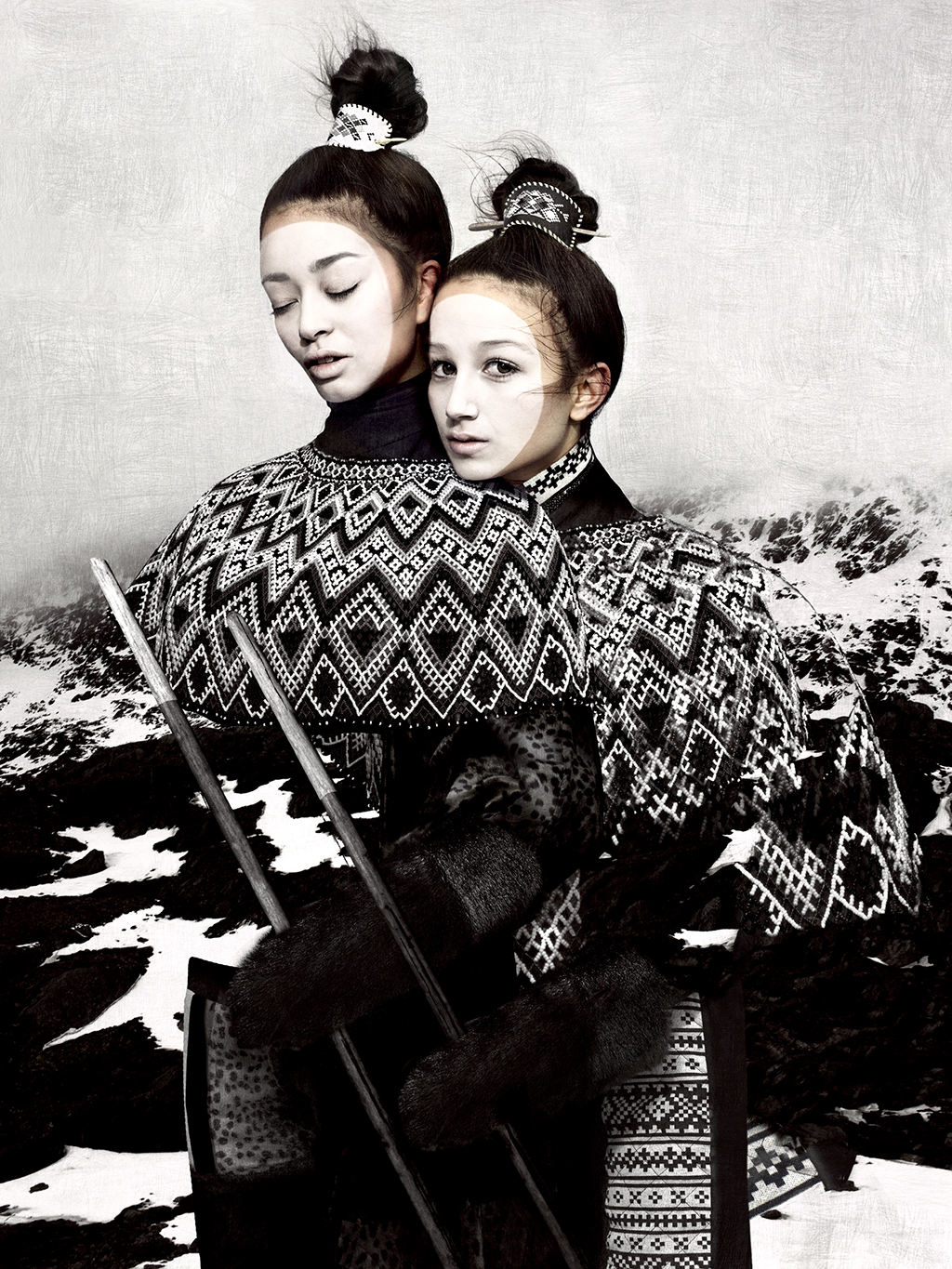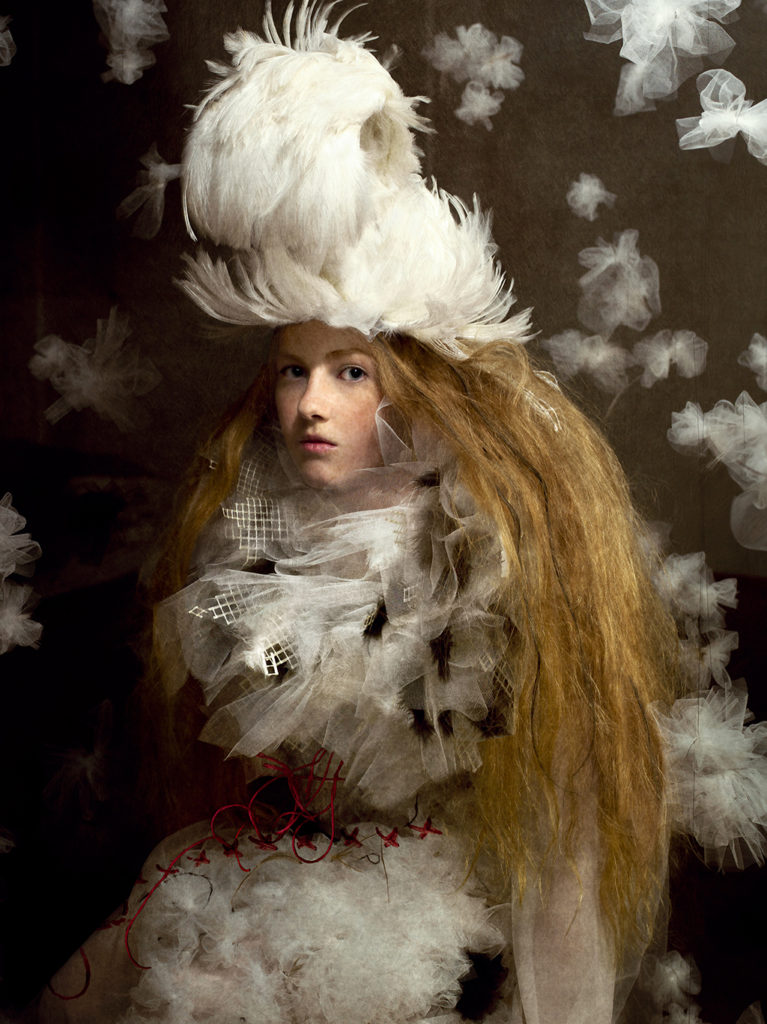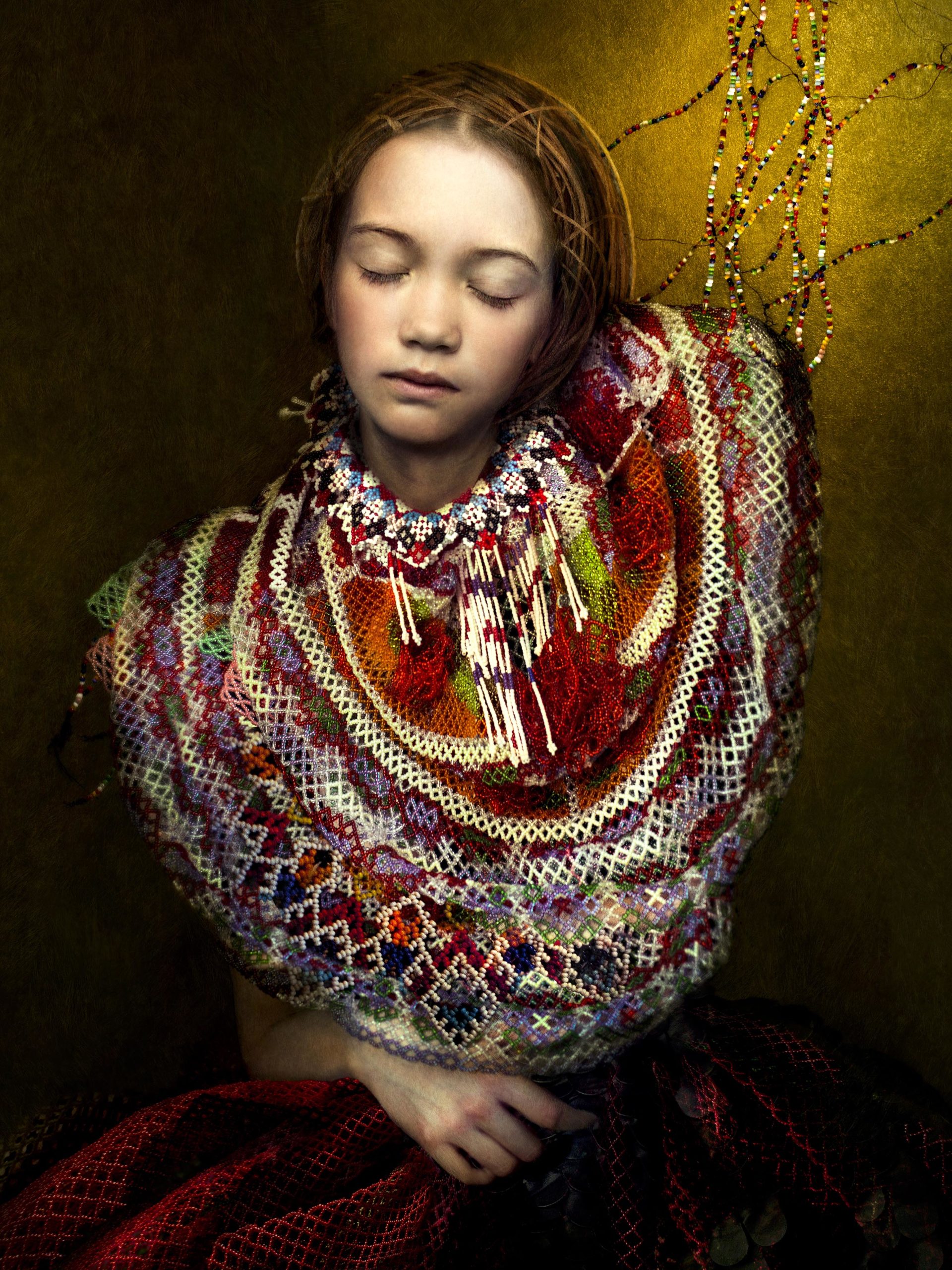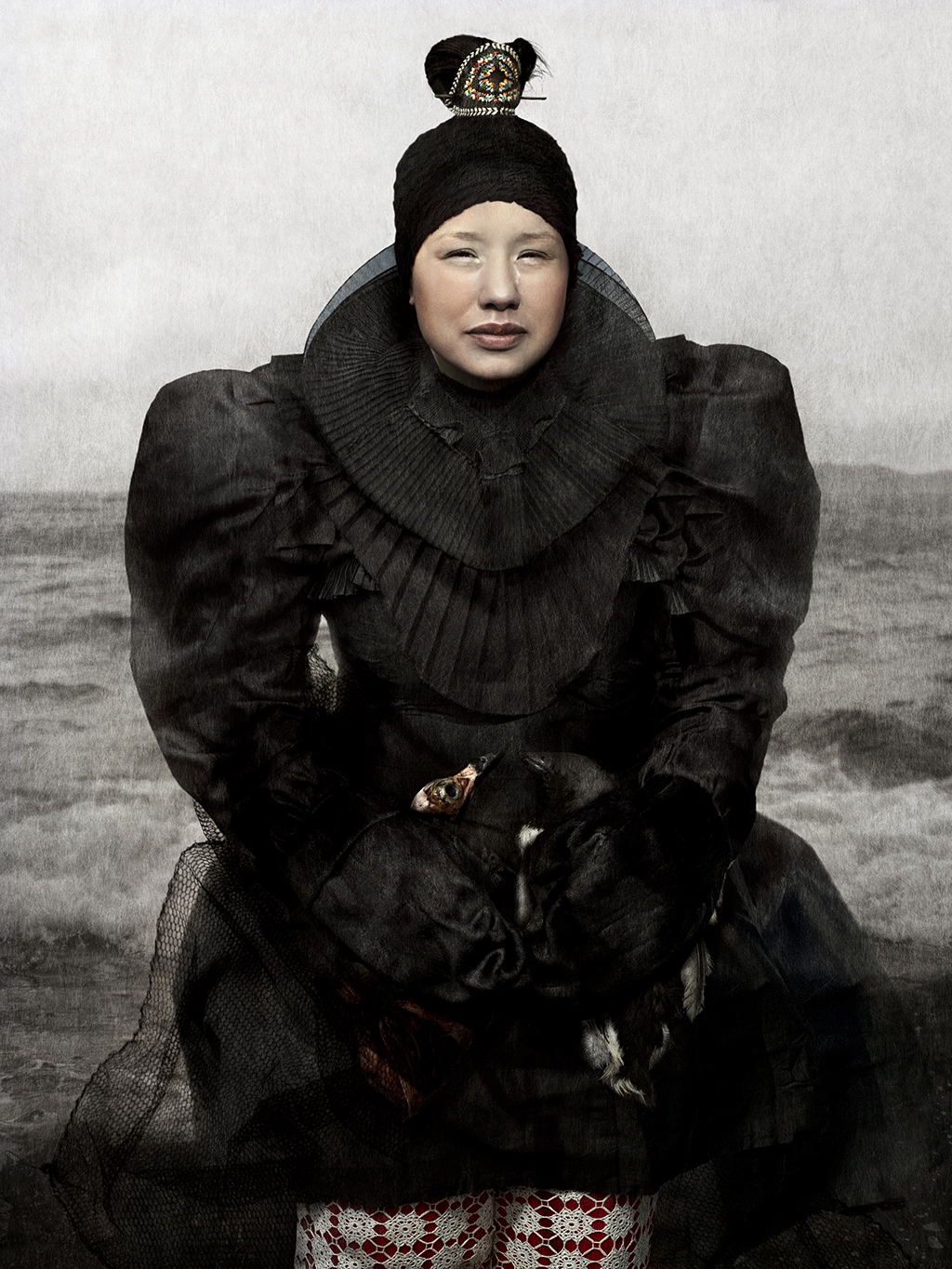The Weather Diaries
Mixing Icelandic fashion, arresting photography, video, and lush installation, a new exhibit at the American Swedish Institute challenges viewers to rethink fashion as an art form and the relevance of designers geographically isolated from Western couture.

Look at her. Return her gaze. It’s difficult, in fact, to look away, so intriguing are the possibilities for narrative and discourse layered into her image. Swathed in tufts of tulle, netting, and feathers, her chestnut hair cascading over the ruffled material, the young woman stares out from beneath a wave of white feathers cresting over her head— immobile, captured, in repose and yet resolute. Highly composed yet enticingly unconstructed, the image conveys a liminal state of being in which animal and human, nature and culture, the feral and the civilized meet to create an aesthetic wholly of another world.
It’s a world in which female agency—it’s all in her gaze—runs like a current within the static image, in which a pre-Raphaelite sensibility encounters the wild, and magical realism goes on a fashion holiday. The image is by Austrian-American artistic duo Cooper & Gorfer (Sarah Cooper and Nina Gorfer), whose partnership began while traveling in Iceland 12 years ago. The image, The Feather Portrait, is of a girl in garb by Reykjavik fashion designer STEiNUNN. And this image is one of the first encountered in The Weather Diaries, currently on view at the American Swedish Institute.
A Cooper & Gorfer production, the exhibition includes large-scale photographs, wall-mounted quotes, documentary film, and installations that use the work of North Atlantic (Iceland, Greenland, the Faröe Islands) fashion designers as the jumping-off point to create an immersive take on their creative practices. The exhibition was commissioned and produced by the Nordic House in Reykjavík, but premiered in 2014 at Museum Angewandte Kunst in Frankfurt as part of the 3rd Nordic Fashion Biennale.
At a time when all things Icelandic hold us in thrall—the violent volcanic fires and rigid ice, the wind and sea, sparse rocky terrain dotted with thermal springs, the sonic booms and electronic wailings of musicians from Ben Frost to Bjork, the mythical allure of the sagas—now, we have fashion, too. But with a materiality that juxtaposes the wild (bones, feathers, fish) with the cultivated (wool, cotton) and the cultured (bead work) in the creation of fantastical works of imagination. Naturally, we wouldn’t expect anything less. Right?

And yet, Cooper & Gorfer are photographers who generate painterly, often collage-like work that calls to mind art history contexts from Klimt to Surrealism to the Old Masters. And the designers with whom they collaborated challenge viewers to question the meaning of fashion as an art form; the relevance of designers geographically isolated from Western couture; the role of cultural heritage in work created less to be worn than to be entered into as an aesthetic experiment.
Then there are the women, from fresh young girls to crone-like elders, who all confront the camera—even when their eyes are closed—with an astonishing presence that defies all expectation of what fashion photography should, could, and yet refuses to be. The Cooper & Gorfer images are highly refined, so choreographed. Yet their compositions work in startling juxtaposition with the wild nature at their heart: not just the female gaze present, but also the skinned birds, the silvery dead fish, the forceful landscape, and the ever-changing weather that are backdrop, object, inspiration for the work and for the women’s presence, front and center.

That initial image, and several others, occupy the Osher Gallery and surround a STEiNUNN installation of white, grey, and black tufts (the same used in the image), which float around a hanging garment like bits of snow and ash. Throughout the mansion are other installations created by fashion designers to accompany Cooper & Gorfer’s images. A burnished animal skeleton lies in a bed of black volcanic rock on a table in the mansion’s dining room, with an image, The Nest, of a woman and girl in Icelandic designer Johanna Methusalemsdóttir’s ethereal white garments sleeping beneath an open air structure hung with their findings. Aglow with light, the woman’s toes cut to resemble an animal hoof, the pair lays in wait in front of a pile of fruit—an offering to the gods? Or, their snack on awakening?
From fresh young girls to crone-like elders, the women in these images confront the camera—even when their eyes are closed—with an astonishing presence that defies all expectation of what fashion photography should, could, and yet refuses to be.
Elsewhere, a knit tunic hangs from the ceiling, surrounded by a ballooning skirt of cloud-like bunches of wool: your local sheep shearer by way of Alexander McQueen, created by Guðrun & Guðrun of the Faröe Islands. Further on, a pale young girl, her blackened fingers covering her mouth, dares through heavily lidded eyes in a black crochet dress that evidences more skin than material: netting from your local fisherman by way of Bob Mackie.
In the portrait Ena Holds the Sea, a girl with rosy cheeks, her eyes closed and mouth open with a sense of quiet satisfaction, inhabits an intricately beaded collar and a skirt of opalescent fish. Nearby is Greenland designer Jessie Kleemann’s 55-pound beaded collar lengthened into a dress, a statement piece intended to represent the ways in which strict cultural traditions founded on questionable materiality (where did the beads come from anyway?) can alternately weigh down or inspire innovation.

Cultural tradition and the nature of landscape, the inability or refusal of escape, are intertwined in the image The Fifth Daughters. Two young women—their faces are ovals of white, with one looking intently at the viewer as the other has eyes closed and mouth open in a dreamlike state—wear intricately beaded collars that fall below their shoulders (the designer is Bibi Chemnitz), their torsos replaced by a landscape of rock and snow. In Sára, Armgarð, and Alda on a Hill, three girls in white caps, white blouses, and wooly skirts by Guðrun & Guðrun sit upright on mossy hillocks above a stream, their toes pointed, as if in anticipation of some upcoming choreography.
In another room of the mansion, a dress with its hem cut into streamer-like lengths of fabric (Iceland’s Gudmunder Hallgrimsson, aka Mundi) hangs overhead, while in a Cooper & Gorfer image nearby, Mundi Sinking, a woman wearing the dress—the streamers tangled about her legs like seaweed or the tentacles of underwater dweller—is shown plunging beneath water’s shimmery surface into the deep, dark depths of the unconscious. Nearby, Mundi’s bizarre films show on a continuous loop, cinematic mysteries in which a 1980s music-video sensibility by way of David Lynch and Game of Thrones convey a violence, psychological intensity, and extravagant costuming that’s at once absorbing and repellant.
On the mansion’s top floor, in the ballroom, a windblown woman in menswear pulls a horse across rugged terrain. Meanwhile, in the center of the space, an installation by Icelandic designer Gudmundur Jorundsson, aka Jor, has faceless mannequins in his striped and crosshatched jackets, pants, shirts, and hoods, struggling up ropes to exit the opening in the ceiling. Whimsical and disturbing, the faceless mannequins seemingly represent yet another mode of resolve, or even defiance, emanating from the women in so many of the images.
Arrested, seized, apprehended. While those descriptors may work for Jor’s installation, they aren’t precisely appropriate for Cooper & Gorfer’s images, almost all of which are of women. Rather, there’s a sense of capture—by the landscape, by tradition, by the camera, by the clothes, by the composition—in the photographs that’s, nonetheless, by turns embraced and resisted.
“They all look like they’re running,” a friend commented, an insight I continue to puzzle over. Running in place, quietly and internally, perhaps, thrumming with their insistence on seeing and being seen as girls and women with agency, wearing high-fashion works of art by designers working far from the arbiters of style and taste, forever rooted in a landscape that breeds a sensibility outsiders can never really know. Look at her, and hear the soul speak.
Related exhibition details: The Weather Diaries is on view at the American Swedish Institute in Minneapolis through July 2, 2017.